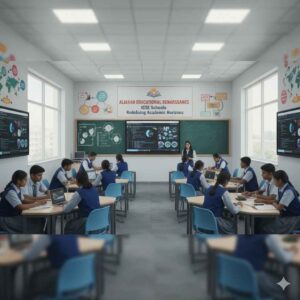The COVID-19 pandemic has irrevocably changed the landscape of education across the world, with India being no exception. While online learning was once considered supplementary or a temporary solution, it has quickly evolved into a core component of the education system. As we step into a new era,e-learningis no longer just an alternative—it’s the future. Frominteractive learning toolstopersonalized educational experiences, the trends shaping the e-learning space in Indian schools are dynamic, exciting, and more relevant than ever.
Let’s dive into the top emerging trends in e-learning that are transforming education for students, teachers, and the entire system. Ready for the revolution?
1. Hybrid Learning: The Best of Both Worlds
Hybrid learning, or blended learning, is quickly becoming the go-to model for schools across India. A mix of in-person and online classes, hybrid learning offers flexibility while maintaining essential classroom interactions.
Why it’s a Game-Changer:
- Flexibility in Learning: Students can attend classes online, especially if they’re unable to make it to school for any reason, whether due to illness, geography, or simply preference.
- Optimized Learning Schedules: Hybrid learning allows teachers to conduct live classes and simultaneously upload pre-recorded lessons for students to access at their convenience.
- Collaborative Learning: With tools like Google Classroom, Zoom, and Microsoft Teams, students collaborate in real time with their peers, bridging the gap between physical and virtual interactions.
Real Insight:
DPS RK Puramin Delhi has seamlessly integrated hybrid learning into its curriculum, allowing students to access lessons from anywhere, ensuring that their learning journey doesn’t get interrupted. Schools likeAmity International Schoolare also incorporating hybrid models for after-school enrichment programs, providing students with a balanced educational experience that stretches beyond traditional boundaries.
2. Interactive and Gamified Learning
The need for engagement is critical when it comes to online education. Enter gamification and interactive learning—two trends that have surged in popularity.
Why it’s a Game-Changer:
- Increased Engagement: Students are more likely to stay engaged with learning materials that are interactive and enjoyable. Think quizzes, puzzles, and challenges that encourage active participation.
- Immediate Feedback: Platforms like Kahoot!, Quizizz, and Duolingo not only make learning fun but also provide instant feedback, helping students track their progress.
- Building Critical Skills: Gamified platforms promote problem-solving, decision-making, and strategic thinking, which are vital skills for today’s fast-paced world.
Real Insight:
The British International School, Mumbai, has implemented a gamified approach to teach subjects like mathematics and science. Students use platforms likeKahoot!to test their knowledge through friendly competitions, earning rewards for their progress. This not only makes learning fun but also motivates students to push their limits.
3. Artificial Intelligence and Personalized Learning
AI is the game-changer that’s transforming traditional e-learning platforms. Personalized learning powered by artificial intelligence can create unique learning experiences tailored to the individual needs of each student.
Why it’s a Game-Changer:
- Customized Learning Paths: AI can analyze a student’s learning style, strengths, and weaknesses to create a personalized curriculum that helps them learn at their own pace.
- Smart Tutoring: AI-driven tutoring systems can offer instant support, providing students with solutions to problems and guiding them through difficult concepts.
- Data-Driven Insights: AI can track student progress in real-time, offering teachers data-driven insights to personalize their approach and adapt lessons based on each student’s unique needs.
Real Insight:
VedantuandBYJU’Shave already started offering personalized tutoring, where AI adjusts the difficulty level based on a student’s previous performance. Schools likeIndus International Schoolare also integrating AI into their e-learning platforms to provide students with adaptive learning experiences that are more efficient and tailored to their specific academic needs.
4. Virtual Reality and Augmented Reality in Education
Virtual and Augmented Reality (VR and AR) are no longer limited to the world of gaming and entertainment—they are making their way into Indian classrooms, opening up new ways for students to experience and interact with content.
Why it’s a Game-Changer:
- Immersive Learning: VR and AR can bring textbooks to life. Imagine walking through ancient civilizations or exploring the human circulatory system in 3D. These experiences make complex concepts easier to understand and more memorable.
- Real-World Applications: These technologies allow students to perform simulations, such as virtual science experiments or even virtual field trips, giving them practical insights without stepping out of their classrooms.
- Boosting Engagement: Virtual learning environments provide an exciting escape from traditional lectures, making learning more engaging and less monotonous.
Real Insight:
The Heritage Xperiential Learning Schoolin Delhi is one of the pioneers in integrating AR and VR into its curriculum. With VR headsets, students can explore topics ranging from space exploration to environmental science, creating an unforgettable learning experience that traditional textbooks just can’t provide.
5. E-Assessment and Automated Feedback
The future of exams is digital, and the shift toward e-assessment has revolutionized the way educators evaluate students. These assessments are faster, more accurate, and can be customized to suit a range of learning needs.
Why it’s a Game-Changer:
- Instant Feedback: E-assessments provide instant feedback, allowing students to understand their mistakes and improve in real time.
- Fairer Evaluation: Automated systems reduce human bias and ensure that all students are graded on the same scale.
- Efficiency: Teachers can evaluate hundreds of assessments simultaneously, making the process faster and more accurate.
Real Insight:
Shemford Futuristic Schoolsacross India use e-assessment tools that enable teachers to monitor student progress digitally. These tools help track individual growth and provide actionable feedback, ensuring that every student gets the attention they deserve.
6. Focus on Digital Literacy and Skill Development
While e-learning offers numerous advantages, it’s crucial that students also develop the digital literacy skills needed to thrive in a tech-driven world. Schools are placing greater emphasis on teaching students how to use digital tools effectively, beyond just learning how to use Zoom or Google Classroom.
Why it’s a Game-Changer:
- Building 21st-Century Skills: Digital literacy equips students with essential skills, such as coding, digital collaboration, and online research, that will serve them throughout their careers.
- Preparing for the Future: As the job market becomes increasingly digital, students who are proficient in using digital tools will have a competitive edge.
- Fostering Independent Learning: With a good understanding of digital tools, students can engage in self-directed learning, making them more adaptable and resourceful.
Real Insight:
Suncity School, Gurgaon, offers aDigital Literacy Programthat goes beyond basic computer skills, teaching students coding, design thinking, and evencybersecurity awareness. This focus on developing tech-savvy students is preparing them for the digital world ahead.
7. Collaboration Tools for Seamless Communication
Collaboration tools are essential for modern education, allowing students and teachers to connect in real time, regardless of their physical location. These tools enhance communication and encourage teamwork, even in a digital classroom.
Why it’s a Game-Changer:
- Real-Time Collaboration: Tools like Google Docs, Trello, and Slack enable students to work together on projects, share ideas, and provide feedback—all in real time.
- Efficient Communication: Teachers and students can communicate seamlessly through chat systems, video calls, and forums, making learning more accessible and effective.
- Global Collaboration: These tools also allow students to collaborate with peers from across the world, fostering a truly global learning experience.
Real Insight:
Ryan International Schoolsacross India use platforms likeMicrosoft TeamsandGoogle Workspaceto encourage student collaboration. These tools make group projects and student-teacher interactions easier and more efficient, creating a digital classroom experience that’s both interactive and engaging.
8. The Future of E-Learning in India: Breaking Barriers
The future of e-learning in India is incredibly exciting. As technology continues to evolve, the tools and platforms available to both educators and students will only get better. FromAI-driven personalized learningtoimmersive VR experiences, the education sector is becoming more dynamic, accessible, and innovative than ever before.
As Indian schools continue to embrace e-learning, students are not just gaining academic knowledge—they are being prepared to thrive in a digital-first world, making them ready to take on challenges far beyond their textbooks.
The Bottom Line:
E-learning in Indian schools is not just about adapting to a new medium—it’s about transforming how students learn, interact, and engage with the world. The trends emerging in e-learning are redefining the classroom, making it more inclusive, interactive, and future-ready. As schools across India continue to innovate, the future of education looks brighter, smarter, and far more exciting.













